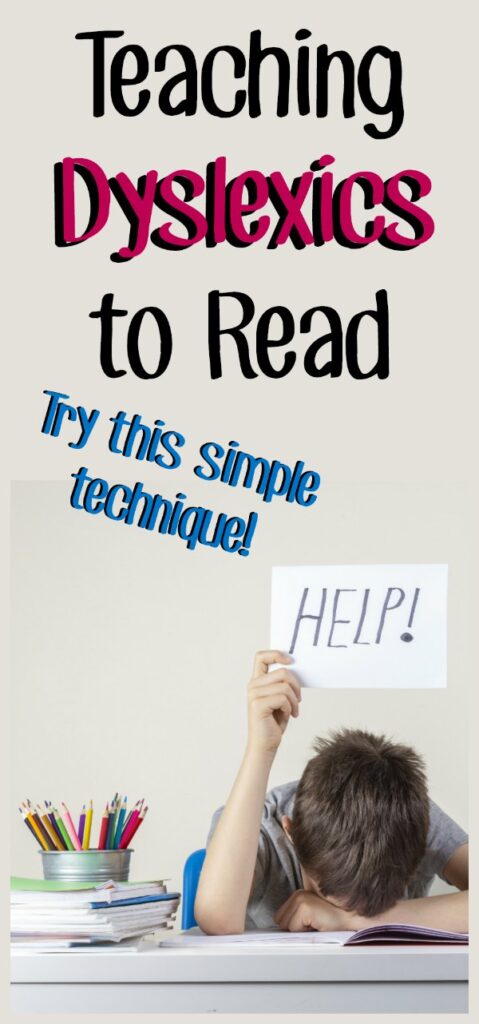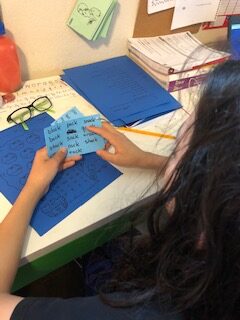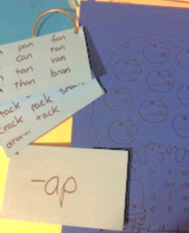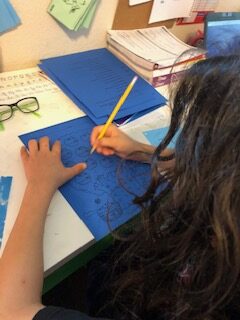Inside you’ll find: How to help a child with dyslexia at home with a simple sight word reading exercise.
Many parents want to know how to teach a dyslexic child to read. This post will begin a new series by my friend Jennifer who is a sensory parent, an adoptive parent, a homeschool parent AND a parent of kids with learning disabilities. She’s such a great resource and I wanted to share her with you!
I have begun using an activity that is rapidly helping with my dyslexic son’s “sight word” vocabulary.
Most students with dyslexia need a lot of extra direct teaching of word patterns and phoneme symbols. Because a person with dyslexia does not consistently “see” a word exactly the same every time they visually see it, their brains do not catalog these patterns and phonemic symbols in the same way typical learners do.
Therefore they need to be told what it is they are supposed to be “seeing” and provided with ample opportunity to “see” it.
This post contains affiliate links for your convenience. Please see my full disclosure policy HERE.
I am using a Scholastic publication, Word Family Trees: 50+ Practice Pages, but any “word family” activity page would work. The Scholastic workbook has one “word family” per page and then 16 initial sounds to choose from in order to make 12 “real” words.
Many learning programs use “nonsense words” to practice blending the parts of words together. This is frustrating to someone with dyslexia because it does not add to their sight vocabulary and is in essence a “waste of time”. Any sort of word family activity could be used or adapted, which will provide practice with a specific word family and a list of 10 – 15 “real” words. For example a word search workpage or some other matching type of activity.
How to Teach Word Families
First give the student a note card with that day’s “word family” on it, big and bold.
Make it visually accommodating. For instance, if your student responds well to dyslexic font consider using that. I use blue note cards to accommodate my son’s Irlen Syndrome.
After going over how that “word family” reads, making sure it is pronounced EXACTLY right, the student then “solves” for the 12 “real words”. When we first started, and for a few of the more challenging sounds, I have to give hints.
I have the student say aloud what they think the word is and then I will either affirm or repeat back to them correctly. Again paying close attention to the nuances of the phonetic sounds.
Related: How to Help a Dyslexic Study Write
An important distinction is short “a” and short “e”. These are phonemic sounds even typical learners struggle to learn to discern, then throw in the fact an “a” and “e” are both rather “round” written symbols, it’s easy to see how they get confused!
This has also been a good activity to expand vocabulary, as some of the words have not been familiar words. Knowing the definition of the word is important to their ability to “visualize” the word and have true meaning behind it.
Finally, after the student has found all the “real” words on the work page, on the back side of the card all 12 words are listed. The student then reads that list in order to solidify those words and that “family”.
This is a good time to make sure the student is “picturing” the word as a word with meaning. For example when we did the “-ent” family we had homophones, “cent”, “scent”, and “sent”. It was important that as he learned to “read” each word he was “picturing” the correct word.
This will not only help his comprehension as he reads, but carry over to his writing and spelling.
The last thing we do for the activity is read through previous word lists. I have found an average of 10 cards, hole punched and stored on a ring, is very doable.
We will “remove” a list after at least a week of fluently reading it. But we will keep working on lists as long as needed.
Looking for another activity to help your dyslexic child? Click HERE.
This is the step that transfers the phonetic reading to “sight word” reading.
Typical students retain sight words just by reading text after text, book after book. A reader with dyslexia needs to be able to “see” the word separately many times before they encounter it in text in order to solidify its appearance.
I also use this time to point out contrasts with word families. For instance “then” is on the “-en” word list and “than” is on the “-an” word list. (There are those tricky visually similar “a” and “e” symbols again!) Reading and writing them correctly make a BIG difference in what you are trying to comprehend or communicate!
The Results
In the two weeks we’ve been using this activity on a daily basis, I can say I’ve seen his reading fluency double with direct correspondence to the 14 word families we have covered so far.
Numerous times when he’s reading; a book, a sign, or a recipe, in these last two weeks, I’ve seen him start to be stuck on a word and I can prompt him with “look for the word family”. Or I’ll cover up the initial sound symbol and he “sees” the word family.
Successful decoding, with comprehension, ensues!
This activity is developing a mental file and organizational system for “retrieving” sight words. This organized and faster system increases reading fluency and writing ability in a way that truly helps a student with dyslexia!
Want More Dyslexia Related Ideas?
- Dyslexia and Writing: Teaching Sequential Thought
- Kinetic Exercise for Sounding Out Words
- Advantages of Homeschooling a Child with Learning Disabilities








[…] Look HERE for another activity to help your child with Dyslexia! […]